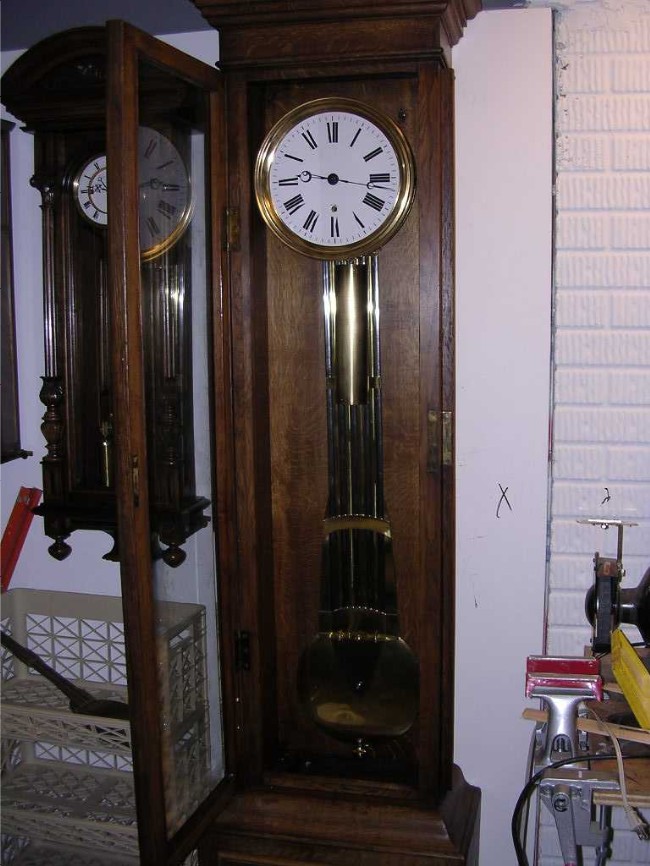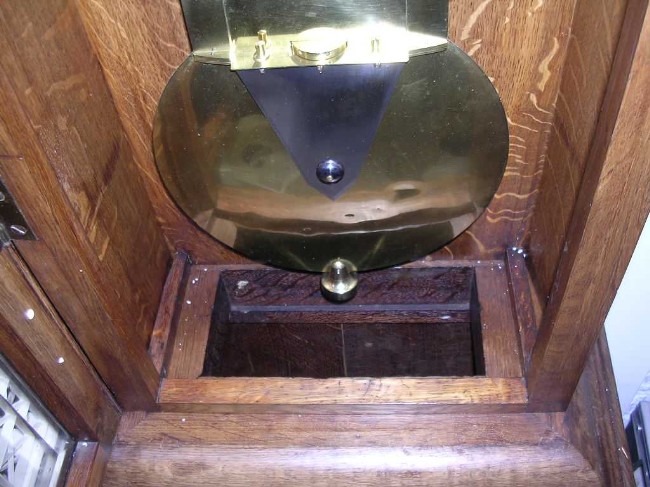
| WWT Shows | CLICK TO: Join and Support Internet Horology Club 185™ | IHC185™ Forums |

|
• Check Out Our... • • TWO Book Offer! • |
Welcome Aboard IHC185™  Internet Horology Club 185
Internet Horology Club 185  IHC185™ Discussion Site Main Page
IHC185™ Discussion Site Main Page  Horological Discussions, Questions and Answers
Horological Discussions, Questions and Answers  Clocks, Including 400-Day Discussions
Clocks, Including 400-Day Discussions  A weight problem or a round weight does not fit a square hole
A weight problem or a round weight does not fit a square hole
 Internet Horology Club 185
Internet Horology Club 185  IHC185™ Discussion Site Main Page
IHC185™ Discussion Site Main Page  Horological Discussions, Questions and Answers
Horological Discussions, Questions and Answers  Clocks, Including 400-Day Discussions
Clocks, Including 400-Day Discussions  A weight problem or a round weight does not fit a square hole
A weight problem or a round weight does not fit a square holeGo  | New Topic  | Find-Or-Search  | Notify  | Tools  | Reply to Post  |  |
| Vienna Regulators IHC Member 313 |
Purchased this French Pinwheel regulator last Spring and after a good cleaning (the pendulum took over 60 hours to disassembly and clean)the clock is up and running. The drop is 1 inch every 3 days. The problem is the round replaced weight that came with the clock will interfere with the pendulum and stop the clock.You also only get a 45 run out of the clock since the weight is so long and you can not drop the weight through the case to the floor which gives app. 60 inch drop for a 6 month runner. Since the weight is not orginal and wear marks on the case may indicate that a rectangular weight may have been used.Since my math is a little rusty as the pendulum was and a little brain teaser is needed on the site every once in a while here is the problem...current weight 2.5 inches diameter, length 10.25 inches, opening to go through 2 inches by 9 inches. Question what is height of the rectangular weight to give the same volume of the currrent weight? Thanks Doug Barr  | ||
|
| Vienna Regulators IHC Member 313 |
Hole  | |||
|
Doug, How about a weight 1.5in x 8.5in x 15.75in high? Is that anywhere near right? I made the weight smaller than the opening for clearance. Tom | ||||
|
Doug, The volume of the round weight is 50.315 cu. inches. (pi R sq. X ht.) To come close to this volume in a rectangular weight it could be 1.5 X 8 X 4.25. This would give you a volume of 51 cu. inches. BTW have you worked out how to keep a rectangular weight parallel with the pendulum bob as it passes? If not I may have a couple of ideas. Regards, Joe | ||||
|
Doug, You are quite sure your pinwheel regulator has the wrong weight because of the interference with the pendulum. Could it also be that the drive weight is too heavy? Dr. David S. Goodman, in his book, This Old Clock, gives a method to determine the proper size (in weight) drive weight for a clock. His method follows. “Mount the clock on a “horse.” Attach a spring “laundry” scale to the end of the weight cord (where the weight would normally be hung). Fasten the other end of the scale to the floor (or whatever!) Wind the clock until the scale registers 20 pounds or so. Start the clock running on the power of the scale. When the clock stops (in about a half hour) read the scale and you know the minimum weight needed to run the clock! Depending on the condition of the clock (clean, lubricated) of the clock, add 10% to 25% to that figure” (for a reasonable weight) I am sure that you could adapt Dr.Goodman’s procedure to your clock to determine, first the amount of weight required, and then obtain a proper sized weight. A drive weight that is heavier than required will cause undue wear in the movement of the clock with time. JMO Best Regards, Dick | ||||
|
Or, you could use another method. I have a Seth Thomas double dial, one weight model. It would run about 4 days. It was original. I finally figured it out. The weight cord should go through a pulley at the top of the case. That halves the weight you need to run the clock, and doubles the duration. You could check your case for a hole in the rear corners of the case top, inside. If a pulley were mounted there, it would drop the weight to one side of the back (hopefully eliminating any harmonic problems with the pendulum), and solve your duration problems. | ||||
|
| Vienna Regulators IHC Member 313 |
Weight is corrrect weight. The problem is it is not the orginal. There is a hole in the top of the maybe there was a pulley their at one time.Keeping a rectangular weight from spinning is also a interesting problem. Any ideas? The plot thickens... | |||
|
Hi Doug, Have you considered two weights side by side on common top and bottom plates? The weight would look somewhat similar to a mercury pendulum. I believe a triangular shaped yoke on the cable wheel that hooked to the weight at two points would keep it parallel to the bob as it passed. I have the materials to fabricate such a weight if you want to go that way. Joe | ||||
|
| Vienna Regulators IHC Member 313 |
people seem to be interested in the movement so here is a picture | |||
|
| Powered by Social Strata |
| Your request is being processed... |
|
Welcome Aboard IHC185™  Internet Horology Club 185
Internet Horology Club 185  IHC185™ Discussion Site Main Page
IHC185™ Discussion Site Main Page  Horological Discussions, Questions and Answers
Horological Discussions, Questions and Answers  Clocks, Including 400-Day Discussions
Clocks, Including 400-Day Discussions  A weight problem or a round weight does not fit a square hole
A weight problem or a round weight does not fit a square hole
 Internet Horology Club 185
Internet Horology Club 185  IHC185™ Discussion Site Main Page
IHC185™ Discussion Site Main Page  Horological Discussions, Questions and Answers
Horological Discussions, Questions and Answers  Clocks, Including 400-Day Discussions
Clocks, Including 400-Day Discussions  A weight problem or a round weight does not fit a square hole
A weight problem or a round weight does not fit a square hole©2002-2025 Internet Horology Club 185™ - Lindell V. Riddle President - All Rights Reserved Worldwide

